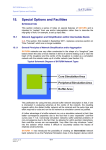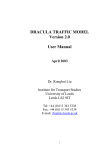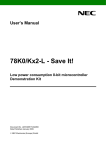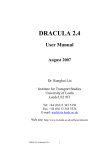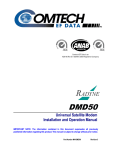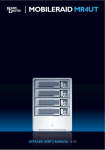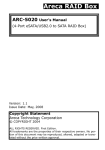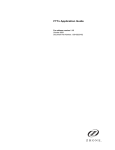Download Appendix D21 - Changes in SATURN Version 11.3
Transcript
SATURN MANUAL (V11.3) Appendix D21 - Changes in SATURN Version 11.3 D.21 Changes in SATURN 11.3 DATE OF LAST UPDATE: 12th NOVEMBER 2014 SATURN 11.3 is the successor to all previous versions of SATURN. Following the full release of SATURN 11.2.05 in March 2013 a series of largely internal releases appeared numbered from 11.2.06 up to 11.2.12 in January 2014. Version 11.3.01 (effectively 11.2.13) was then released in Beta version, with a full release of 11.3.03 in April 2014. A further update release of 11.3.07 took place in October 2014. As always, in terms of backwards/forwards compatibility, the 11.3 network .dat files may contain new features (e.g., parameter names) which will not be recognised by pre 11.3 versions of SATNET but will not cause the program to crash; however pre 11.3 .dat files will be read perfectly happily by 11.3 SATNET. Similarly 11.3 network .ufs files contain new arrays which older version exe’s will be able to read but not recognise whereas 11.3 exe’s will be able to read pre 11.3 ufs files. Matrix .ufm files have not fundamentally changed and should be both forward and backward compatible. In terms of results there have been a limited number of minor changes to the simulation but nevertheless one might expect 11.3 to give different – possibly significantly different – results to pre 11.3. Our advice therefore would be to rerun old networks “from scratch” and certainly not to do comparisons between 11.3 outputs and pre 11.3 outputs. The following sections describe the changes made in SATURN 11.3 (and/or in the later versions of 11.2). Each note should give the precise release number in which the change was introduced (e.g., 11.3.2), the date and references to relevant sections in the Manual. D.21.1 SATNET and Network Definitions 1) The rules for NOXYC = T have been relaxed such that if zones are identified within 55555 co-ordinate data records by their numerical range only (i.e., a C is not used in column 1 to designate a zone) then if a number in the correct range (<= MAXZN) cannot be identified as a zone it is tested as a node number. 11.2.6. 18/05/13. 2) An extra set of dummy links have been included at external simulation nodes with two or more connections to internal simulation nodes in order to allow all possible turns to/from internal simulation nodes. In particular this has important implications for the way in which .UFC route flows are converted into UFO flows and, in general, reduces the differences between the two sets of alternative link flows. See 18.9.3. 11.2.6. 11/06/2013. 3) The maximum number of count sets under 77777 increased to 405 from 120. 11.2.8. 15/09/13. 4) The maximum number of records contained in the network “history file” has been increased from 20 to 101. 11.02.09. 14/10/13. 5120257 / Nov 14 11_3_08_App D21.docx E-154 SATURN MANUAL (V11.3) Appendix D21 - Changes in SATURN Version 11.3 5) Certain error messages related to links, not nodes (e.g., warning 42 for counted links which are bridged by centroid connectors) are now associated with the nodes at either end of the link. 11.2.09. 01/10/13. 6) Free-flow and capacity times as input on simulation link speed-flow records may now be input as pure delays which are to be added to the normal link cruise times as opposed to inputting total travel times as previously. See 6.4.12.2. 11.2.10. 24/11/13. 7) New advice has been provided on how to model mid-link pedestrian junctions as simulation nodes or, preferably, as part of link capacity-restraint curves. See 6.4.3.6 and 6.4.12.3. 11.2.10. 24/11/13. 8) A new logical Namelist parameter BYCAPI has been added to control the calculation of disaggregate summary statistics. Thus, in order for statistics by capacity index to be calculated by SATALL/SATSIM, BYCAPI must be T (and the alternative BYGRUP = F). In previous releases BYCAPI was, in effect, T. See 15.59.2. 11.2.12. 01/02/14. 9) In order to conform with DfT recommendations the default values for parameters controlling the convergence of the simulation-assignment loops have been changed so that: (a) KONSTP = 5 (both flow and GAP criteria need to be satisfied), (b) PCNEAR = 1.0%; (c) ISTOP/RSTOP = 98%/97/5%; and (d) NISTOP continues as 4. Release 11.3.2. 14/03/14. 10) A minor change under AUTOX: if a link distance is not available for a new external link the distance is calculated from the crow-fly distance instead of a default of 100 m (assuming that SHANDY = T which it should be). See Section 15.12. Release.11.3.2. 17/03/14. 11) A new Serious Warning 187 identifies a problem with X-turns at signals where some green phases are terminated by a late (unopposed) cut-off but some are not. The problem is whether TAX is allocated or not. See Section 8.2.4.1. Release 11.3.4. 16/06/14. 12) If FREE77 = T in a network .dat file then the whole 77777 record including the node definitions is now read in free format, not fixed columns, so that it is now (normally) essential that a value of zero is explicitly included as the C-node when A-B denotes a link. See note 13), 6.10. There are, however, two exceptions to the rule of an explicit C-node; (1) if there are only 3 items in total on the line they are assumed to be “A B Count” and (2) if the 3rd item is real (i.e., has a decimal) then it is assumed to be a count, not a C-node. See note 14), 6.10. Release 11.3.4. 01/05/14. 13) The check for very small stacking capacities has been tightened up such that a stacking capacity of less than 1 PCU per lane now leads to a Serious Warning 188, given that such small stacking capacities can play havoc with the convergence of blocking back calculations. In addition the test is now based on chain stacking capacities. Release 11.3.5. 25/06/14. 14) Serious Warning 165 – an X-turn at signals has two or more lanes allocated and the inside lane is shared with, say, straight ahead traffic – is no longer applied if the straight ahead traffic has other (further inside) lanes that it may use if the shared lane is blocked by the X-turners. Release 11.3.5. 26/06/14. 5120257 / Nov 14 11_3_08_App D21.docx E-155 SATURN MANUAL (V11.3) Appendix D21 - Changes in SATURN Version 11.3 15) D.21.2 D.21.3 New checks have been introduced such that data which is normally read in fixed columns (e.g., powers and capacity indices within 11111 and/or 33333 link speed-flow records and counts under 77777) is also read using free format which should give the same result. Any differences – which may be due to data in incorrect columns – are flagged as either Serious Warning 189 (link speed-flow) or 190 (counts). Release 11.3.6. 20/07/14. SATALL 1) The algorithms used to calculate .UFO files from Frank-Wolfe .UFC files have been substantially improved in release 11.2.05 both in terms of their accuracy but also in terms of the required CPU time. In particular a multicore element has been introduced and enabled when MULTIC=T (and which effectively renders SATUFO_MC redundant). See 15.53. In addition further significant improvements have been introduced in version 11.2.7 – 18/06/13 (and subsequently incorporated into version 11.2.05U as well). 2) Continuation runs of SATALL (e.g. SATALL net MASL 1) will not now automatically create .UFC files by running an extra SAVEIT assignment unless the parameter SAVEIT is explicitly entered on the command line (e.g., SATALL net MASL 1 SAVEIT). The reason is to avoid wasting extra CPU time when it may not actually be required. See 9.12.1.1. Release 11.3.3. 01/03/14, Simulation 1) Further revisions to the modelling of flares have been made, in particular to deal with the situation where the “straight ahead” traffic that shares with the flared turn can use two or more lanes such that traffic from the “non-flared” lane can move over into the “flared” lane to take advantage of the space available in the “flared” lane which is not being fully utilised. See section 8.2.6.3. 11.2.8. 01/10/13. 2) New rules have been introduced to deal with situations where a link with an explicit capacity limit (i.e., from a speed flow curve) has an arrival flow exceeding its capacity such that all the exit turns are aggregated into a single “river” (see 8.8.2). Thus, for example, random delays per turn are calculated for the river/link as a whole rather than individually. However if the lanes are already shared then the new rules do not apply. In practice, this will only apply to considerably fewer than one link per thousand. 11.2.9. 03/11/13. 3) Output simulation summary statistics (as output by either P1X or SATLOOK) may now be disaggregated either by traffic borough (using TfL conventions) or by explicitly defined node “groups” defined by a .N2G file (FILN2G in .dat files). See 5.1.7, 11.11.4 and 15.59. 11.2.9. 03/11/13. 4) Flow-weighted average link times which include the effect of CLICKS on certain user classes are calculated and stored as either DA code 4008 (weighted by vehicles) or 4018 (or weighted by PCU) in output .ufs files from SATALL. See 15.47.4. 11.2.10. 11/11/13. 5) A number of relatively minor “improvements” have been made to the node simulation, primarily to deal with a number of “funnies” in the lane allocation 5120257 / Nov 14 11_3_08_App D21.docx E-156 SATURN MANUAL (V11.3) Appendix D21 - Changes in SATURN Version 11.3 algorithm and/or flows in excess of mid-link capacities. Overall differences are expected to be small. Release 11.3.2. 17/03/14. D.21.4 6) Similarly a number of minor “improvements” have been made to the way in which assignment speed-flow curves are calculated based on simulation data, hopefully resulting in marginal improvements to the overall convergence. Release 11.3.3. 22/03/14. 7) A further addition to the modelling of flares extends the principle outlined in 1) above where turning movements which “share” a lane with the flared movements are allocated extra capacity in an adjacent lane. Now “other” turning movements which share that adjacent lane may also have their capacities increased (the “knock-on effect”). This is applied to both signals (11.3.6) and, subsequently, priority junctions (11.3.7). See Section 8.2.6.3. 11.3.7. 05/08/14. 8) An error has been corrected in the calculation of total network bus-hours and bus-kms. Previously, if a link had a bus lane but certain bus routes on that link were deemed not to use the bus lane (e.g., the route took an exit from the offside lane but the bus lane was on the nearside) then those buses were excluded from the calculations. The new bus-hrs etc. are therefore very marginally larger than the old. The same correction also applies to total pcu-hrs etc. Release 11.3.7. 23/08/14. 9) A small adjustment in the lane choice model improves the allocation of flows to 2 or more lanes which are only used by a single turning movement. Examples where this applies (a) are rare and (b) have very little overall impact on delays etc. but the 11.3.8 simulation will produce marginal differences from previous versions. Release 11.3.8. 12/11/14. P1X and/or SATDB 1) A new option has been added when adding Capacity Indices as global variables to a .dat file to ensure that all data in columns 11 to 40 is blanked out so that the newly defined index will uniquely define the link speed-flow curve. 11.2.6. 24/04/13. 2) An added option under ME2 Analysis allows links which were included in a particular combined (666) constraint set to be selected, thereby making their identification much easier. Sections 11.8.5 and 13.8. 11.2.6. 26/04/13. 3) Furthermore, a selected set of combined constraints may be subject to Select Link Analysis directly, the prime function of which would be to detect multiple crossings. (Alternatively, a set of 666 combined constraints may be selected as a screen line under SLA although it is more convenient to do it under ME2 Analysis.) 11.2.6. 28/04/13. 4) The use of solid bars to indicate selected links which are currently centred on the link independent of which direction is selected may now be made “directional”, i.e., along the direction of travel. 11.2.6. 27/04/13. 5) Zones may now be nominated numerically using their sequential numbers as opposed to their “name”, e.g., in selecting origins and destinations for tree building. 11.2.6. 06/05/13. 5120257 / Nov 14 11_3_08_App D21.docx E-157 SATURN MANUAL (V11.3) Appendix D21 - Changes in SATURN Version 11.3 6) Joy rides and analyses of timed routes (Validation) may now alternatively use average stop delays as calculated on a link AB rather than the turnspecific delay at B. See 11.7.2.1 and 11.8.2. 11.2.6. 11/06/13. 7) SLA calculations based on .UFC files now use double precision variables in order to avoid “losing” trips due to rounding errors. 11.2.7. 18/06/13. 8) There is a subtle change in the output statistics for SLA link flows in that the original Demand and Actual flows now exclude any fixed flows so that they are more directly comparable to the reported SLA flows which also do not include any fixed flows. 11.2.7. 18/06/13. 9) A new batch file, P1XDUMP, similar to DBDUMP will also dump selected data from a .UFS file to text files but using the P1X internal codes (see Appendix I.1) rather than DA codes. See 15.46.2. 11.27. 30/08/13. 10) Two new options under Information list (a) the “History Records” (6.2) on their own and (b) all the “must have” files, i.e. all the files such as the trip matrix file which are essential to run this network plus a list of all the $INCLUDE records from the original .dat file which also are “essential” files. See 11.8.4.10 and 11.8.4.11 respectively. 11.2.9. 11/10/13. 11) TfL Traffic Boroughs and/or Groups per node/zone may be selected as node data for display either in P1X plots or in SATDB node data bases. 11.2.9. 03/11/13. 12) KEY file control may be initiated from within P1X rather than via the command line. Access is via the Files Menu. See Section 11.4.5. 11.2.10. 16/11/13. 13) 2 new options in SATDB Miscellaneous Data add (a) link saturation flows and (b) number of lanes per turn with negative values to indicate bus only (following the conventions used for data inputs in SATNET). See Section 11.6.10.8. 11.2.10. 23/11/13. 14) An option “SLA in a Basket” has been provided in order to undertake SLA calculations in a semi-batch mode. Basically the user selects a set of SLA’s which are added to a “basket” and, at the end of the SLA selection, the full set of calculations take place, at the end of which the program terminates. Ideal to set up a long weekend run on Friday afternoon! See Section 11.8.1.14. 11.3.3. 22/03/14. 15) The maximum number of selected nodes within SLA has been effectively doubled from 9 to 19. 11.3.3. 22/03/14. 16) A policy of minimising the number of “to screen” operations which take place while P1X is running in KEY-VDU mode has been initiated on the basis that there is no real reason to, e.g., mark selected nodes with a star on the screen if nobody is looking at it. Hopefully this will reduce the number of times P1X outputs “interrupt” concurrently running windows. 11.3.5. 19/06/14. 17) A new option (#30) in the standard tables for simulation nodes lists all the link times and speeds including, per user class, the extra delays due to 5120257 / Nov 14 11_3_08_App D21.docx E-158 SATURN MANUAL (V11.3) Appendix D21 - Changes in SATURN Version 11.3 CLICKS. The vehicle- and PCU-weighted times/speeds are also printed. Section 11.11.1. Release 11.3.5. 27/06/14. D.21.5 18) Under node graphics editing, a node may now be simulated even if it has warnings etc. that have been upgraded to Fatal Errors under WRIGHT = T but with a NAFFS ALERT message attached. So if the program crashes you have been warned! 11.3.5. 08/07/14. 19) Information on (bus) routes may now be restricted to certain classifications of routes, e.g., only routes with timing points, only routes with positive bus frequencies, etc. See 11.8.4.2. 11.3.07. 18/08/14. 20) When tracing routes link by link, e.g., a bus route or an O-D tree as joy-ride, the display of every individual link data in the banner (which may take a large number of clicks to work through) may now be fast-forwarded to the end of the route by clicking on Up1 in the menu bar. 11.3.07. 20/08/14. 21) Routes may now be optionally nominated by typing in their text name rather than pointing to a line in the banner. 11.3.07. 25/08/14. 22) A new option under Files/Output creates a Bus Route text file with one record for every link within every coded route. The format is ad hoc and has been created at the request of one particular user; extensions/modifications could be easily accommodated. See 11.4.2.4. 11.3.07. 05/09/14. 23) The modelled times used in the Validation of routes may now be based on times which include contributions from added CLICKS delays, either for an individual user/vehicle class or a weighted average by vehicle or PCU flows. Such times may correspond more closely to the sources of the observed travel times. See Section 11.7.2.1. Release 11.3.07. 09/09/14. 24) Similarly CLICKS times may be added to the cumulative times for joy rides. See 11.8.2.3. 11.3.07. 10/09/14. 25) Two new data items have been added to the standard lists of node data: (1) the maximum reduction in V/C per node following signal optimisation and (2) the maximum stage length shift following optimisation. 11.3.08. 7/10/14. 26) Requests to list the full data base contents (link and/or node) to the screen may now be requested directly from the graphics menus where link and/node data is added. 11.3.08. 7/10/14. 27) Under Convergence/10 Worst listings the lists may be restricted to a single entry per node or per link – as opposed to the current practice where entries are printed per individual turn so that, say, it is possible for all 10 worst entries to refer to the same simulation node. 11.3.08. 7/10/14. 28) Under Convergence/10 Worst listings the data may also be stored directly as a data base column (either link or node) and an ordered list may be optionally displayed directly from the Convergence menu. This enables the top 20, 30, etc. entries to be displayed. 11.3.08. 7/10/14. MX 5120257 / Nov 14 11_3_08_App D21.docx E-159 SATURN MANUAL (V11.3) Appendix D21 - Changes in SATURN Version 11.3 1) An internal matrix within MX may be designated as a TfL matrix via a toggle option 16 under Main Menu Option 1, following which certain new options become available. See point 4) below. 11.2.1. 27/11/12. 2) Added option to set all row/zone “names” to their sequential values; useful, e.g., after editing and/or renaming the current set of zones. Option 15 from main menu 1. 11.2.6. 11/06/13. 3) An option to automatically compress a matrix based on TfL zoning conventions to a 45 x 45 traffic borough matrix has been created. See Section 10.4.4 for the aggregation of the internal matrix and 10.16.4 for the output of an aggregated .ufm matrix. 11.2.9. 08/10/13. 4) Similarly, more general options compress a zone-to-zone matrix into a “group-to-group” matrix based on a .Z2G control file (where a “group” could be a “sector”, a traffic borough, etc. etc.). See 10.4.4 and 10.16.4. 11.2.11. 16/12/13. 5) By contrast another option “expands” or “decompresses” a matrix defined in terms of, say, group to group movements into one defined by zone to zone movements whereby all zone-to-zone values take the same corresponding group-to-group cell value. This could be applied to a matrix of, say, OD costs or factors but not, logically, to a trip matrix where the group-to-group trips would need to be factored down when disaggregated to a zonal level. See 10.4.5 and 10.16.5. 11.2.6. 11/06/13. 6) Batch files to automatically carry out new options 3), 4) and 5) above have also been created: MXZ2G, MXZTB and MXG2Z. See 10.20.22/23/24. 11.2.11. 16/12/13. 7) The “structure” of .UFM files has been enhanced such that a matrix which has been compressed from zone-to-zone to group-to-group “remembers” the original zone definitions and the correspondence between zones and groups such that the original zonal matrix can be automatically opened and/or re-created without direct user intervention. 11.2.12. 05/01/14. 8) The “order” of the options under main menu item 14 – create an output .UFM file – has been “rationalised” such that the option to use an M5 control file is now number 3, not 5. This may therefore affect any user-set key files which use the M5 option such that an entry 5 must be changed to 3. In case of queries please contact DVV and/or Atkins. 11.2.12. 05/01/14. 9) A “reboot” option allows the original command line to be re-processed if the zonal structure has been transformed in some way. The idea is that if you input a zonal matrix and then compress it to a group matrix (see points 8 and 9 above) in order to “view” the matrix in terms of group-to-group you may return to the original zone-to-zone version. This therefore gets around a “feature” of MX whereby you cannot store a zonal matrix and a group matrix in internal memory at the same time but this way you can swap between them. See 10.4.6. 11.2.12. 18/01/14. 10) A new batch file MXDIVIDE divides one matrix by another cell by cell. It is useful, for example, to calculate growth factors between two trip matrices. See 10.20.25. 11.1.12. 01/01/14. 5120257 / Nov 14 11_3_08_App D21.docx E-160 SATURN MANUAL (V11.3) Appendix D21 - Changes in SATURN Version 11.3 D.21.6 D.21.7 SATPIJA 1) A Namelist option USEUFO allows SATPIJA to use a .UFO file – assuming that one has been created for the network in question either by using OBA in the first place or by SAVUFO/SATUFO with Frank Wolfe – in preference to a .UFC file, potentially resulting in very much reduced CPU times. See 13.3.14. 11.2.7. 20/06/13. 2) The calculations based on .UFO inputs (i.e., following either OBA or SATUFO with USEUFO=T) have been made faster and now include the test to exclude IJ cells from the output .UFP file if there are zero trips in that cell in the trip matrix. 11.2.7. 03/07/13. 3) A new Namelist parameter USESPI = T allows calculations to be based on spider networks. But, N.B., not yet available for all options; e.g., it does not work with GROUPS = T. Proceed with care! 11.3.7. 10/08/14. SATME2 1) The output .ME2 file has been extended so that it contains, e.g., target flows, errors, etc., per combined constraints but associated with each of the individual links. Thus in P1X all the links within the same combined set will have the same attributes displayed which makes it easier to identify combined sets. See Section 13.8. 11.2.6. 22/04/13. Matrix estimation may now be undertaken based on aggregates of zones (e.g., sectors, traffic boroughs, etc.) rather than individual zones, involving changes to both SATPIJA and SATME2. See Section 13.5. 11.2.12. 03/02/14. D.21.8 2) The .LPM file now gives a complete list at the bottom of all the Warnings etc. encountered during the run and the number of times each has occurred. In addition all errors have been assigned numbers. 11.3.5. 09/07/14. 3) Two extra output tables, 12c and 12d, have been added to do a basic statistical comparisons of the trip matrix trip ends, input and output, as required (in part) for standard DfT TAG Unit M3.1 (previously Unit 3.19) Table 5 statistics. 11.3.6. 28/07/14. 4) In addition a full summary table of those statistics required by DfT TAG Unit M3.1 (“Table 5”) has been included. 11.3.6. 28/07/14. SATLOOK / Skimming batch files 1) A new batch file SKIMDA has been created in order to do a forest skim on any DA code as opposed to, say, SKIMDIST which operates using a specific DA code. See 15.27.7. 11.2.08. 29/09/13. 2) Network summary statistics, which previously could be output disaggregated by link capacity indices, may now also be disaggregated either by “traffic boroughs” defined by TfL zonal name definitions or, more generally, into “groups” as defined by an input file FILN2G as set in the original network .dat file or interactively defined within SATLOOK. See 11.11.4 and 15.59. Release 11.2.09. 12/10/13. 5120257 / Nov 14 11_3_08_App D21.docx E-161 SATURN MANUAL (V11.3) Appendix D21 - Changes in SATURN Version 11.3 D.21.9 3) An option has been added under main menu option 4 to allow statistics for all different types of flows to be printed in a single pass (and also therefore output to a CSV file in a single pass). 11.2.12. 12/02/14. 4) Bus summary statistics (main option 6) now automatically create a CSV file with one row per route containing all relevant statistics, such as travel times, distances etc. 11.3.07. 8/9/14. New SPIDER Network Applications/SATCH 1) D.21.10 D.21.11 New Namelist variables USESPI and USEUFO have been added in SATCH in order to more easily turn on or off the use of SPIDER networks and/or UFO (in preference to UFC). See 12.1.1.3. 11.2.11. 18/12/13. General Changes 1) The “rules” for using 99999 to terminate data inputs have been tightened up for certain input files, for example, the input to MXM5 as described in Appendix W, so that “truncated” 99999 records such as a single 9 followed by two or more blanks no longer are interpreted as an end of data set record. This means that defining zones or nodes with numbers such as 9, 99, etc. will no longer be misinterpreted as end of data sets. N.B. These changes do not apply at all to SATNET inputs. 11.2.08. 15/09/13. 2) For all interactive programs such as P1X, MX, etc. a listing of the .LOG file is given at the bottom of the .LP file – useful for recreating the run without necessarily still having a copy of the actual .LOG file. See 14.5.1. Release 11.2.11. 13/12/13. SATWIN 1) A new SATWIN graphical user interface (GUI) was developed for the 11.2 release (using Microsoft WPF) to replace the existing SATWIN version (after a decade of good service!). The new SATWIN updates the existing workflows and enables model specific set-up and operations and to be saved and re-loaded. See section 3. In August 2013, SATWIN11 Service Pack 1 (v11.6.01 Beta) was released providing: - - An improved quick start screen providing access to your most recent Model Complex files in a single click as well as a prompt to save prior to exit; Restructuring of the groups of SATURN modules and new icons; Major updates to SATWIN command line calls to provide full integration with the existing SATURN batch files; and Increased stability and resilience. 2) A restructuring of the ribbon groupings and program icons undertaken to improve the model workflow. SATWIN11 Version 1.6.02. Release 11.3.03. 28/03/14. 3) A new web-based help version of the User Manual created from the existing documentation to make it more accessible and easier to undertake searches 5120257 / Nov 14 11_3_08_App D21.docx E-162 SATURN MANUAL (V11.3) Appendix D21 - Changes in SATURN Version 11.3 and navigation. Available in Beta form. SATWIN11 Version 1.6.02. Release 11.3.03. 28/03/14. 4) D.21.12 DRACULA and PT-SATURN 1) D.21.13 A number of minor bug fixes undertaken following user feedback. SATWIN11 Version 1.6.03. Release 11.3.07. 19/09/14 Some overdue housekeeping – access to the DRACULA and PT-SATURN products has been removed from the SATURN 11.3.03 onwards. New Licence Levels (N4 and X7) 1) The existing Licence Levels beyond the standard N3 level were restructured with the v11.2 release to remove the proliferation of bespoke versions for individual applications. The source code has also been restructured to reduce memory requirements for these larger levels with a new standard ‘N4’ introduced. The changes are summarised below: Array / Level Simulation Junctions B to N3 Standard N3 ‘Standard’ N3’ Inter’ Removed levels Assignment Links Zones* Unchanged – see Section 15.28 21,000 200,000 (No change) (No change) 21,000 700,000 N3 ‘Large’ 2,000+ (default) (No change) 2,750+ Bespoke N4 23,000 200,000 4,000 X7 30,000 250,000 5,750 Note: ‘+’ the maximum number of zones is 8,250 and it is available upon request. (N.B. There is a risk that some of the Multi-Core versions of the existing applications may not be available in the larger sizes). Note: With the internal restructuring, there may be some issues of backward compatibility for very large networks using SPIDER Network Aggregation. The networks may not be able to be opened in subsequent versions of P1X. In these situations, the user should revert back to the earlier version of P1X from the original SATURN version used to create them. IJW / DVV – 07/10/14 5120257 / Nov 14 11_3_08_App D21.docx E-163 SATURN MANUAL (V11.3) Appendix D21 - Changes in SATURN Version 11.3 Version Control JOB NUMBER: 5120257 Revision DOCUMENT REF: App D21.doc Purpose / Description Originated Checked Reviewed Authorised Date 10.9.10 SATURN v10.9 Release DVV DG IW IW 04/09/09 10.9.12 SATURN v10.9 Release (Full) DVV DG IW IW 22/10/09 10.9.22 Web release – Dec 10 DVV AG IW IW 06/12/10 10.9.24 SATURN v10.9 Release (Full) DVV AG IW IW 06/05/11 11.01.09 SATURN v11.1 Release (Full) DVV AG IW IW 31/03/12 11.01.10 Web release- Sep 10 DVV JS IW IW 14/09/12 11.2.01 SATURN v11.2 Beta Release DVV JS IW IW 07/12/12 11.2.05 SATURN v11.2 Release (Full) DVV JS IW IW 31/03/13 11.3.03 SATURN v11.3 Release DVV EN IW IW 28/03/14 11.3.07 SATURN v11.3.07 Release DVV DAS IW IW 26/09/14 11.3.08 Latest for UGM 2014 Nov DVV MH IW IW 12/11/14 5120257 / Nov 14 11_3_08_App D21.docx E-164












